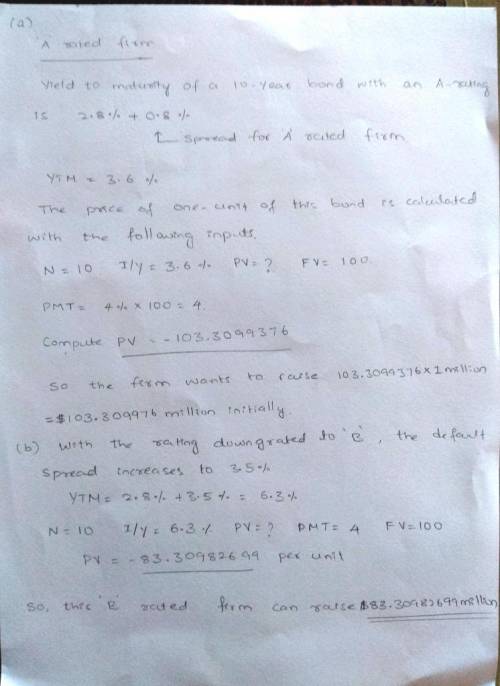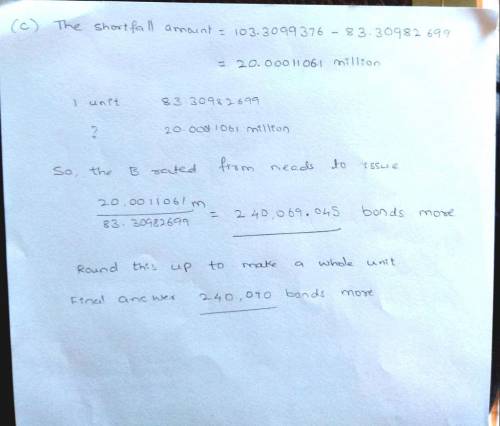
A firm with an A rating plans to issue one million units of a 10 year-4% bond with face value $100. After the financial crisis this firm is downgraded to a B rating. The yield curve increases 0.2% per year. The yield for year 1 is y1=1%, for year 2 is y2=1.2%, y3=1.4% and so on and y10=2.8%. The default spreads are given in the table below.
(a) What is the initial amount (before downgrading) the firm wants to raise?
(b) How much can this now B rated firm raise?
(c) If the firm wants to raise the planned amount, how many more bonds does it issue?
Rating Default spread
AAA 0.20%
AA 0.40%
A+ 0.60%
A 0.80%
A- 1.00%
BBB 1.50%
BB+ 2.00%
BB 2.50%
B+ 3.00%
B 3.50%
B- 4.50%
CCC 8.00%
CC 10.00%
C 12.00%
D 20.00%

Answers: 2
Another question on Business

Business, 21.06.2019 20:30
Long-distance providers are becoming increasingly concerned about certain activities within their industry. various companies come together voluntarily to implement new standards of social responsibility that members must abide by. what seems to be the primary motivation in this case for an increased interest in social responsibility? - because corporations are creations of society, they are responsible for giving back to the communities in which they operate.- these companies have realized it is in their best interest to increase their social responsibility before they are once again subject to stricter regulations.- these companies are using social responsibility as a means to increase their profitability, both short term and long term.- long-distance providers have started taking pride in their industry and its record for social responsibility.- they feel a responsibility to their stockholders, employees, the government, investors, and society as a whole.
Answers: 2

Business, 21.06.2019 21:30
Gino's restaurant is a popular restaurant in boston, massachusetts. the owner of the restaurant has been trying to better understand costs at the restaurant and has hired a student intern to conduct an activity-based costing study. the intern, in consultation with the owner, identified the following major activities: activity cost pool activity measure serving a party of diners number of parties served serving a diner number of diners served serving drinks number of drinks ordered some costs, such as the cost of cleaning the linens that cover the restaurant's tables, vary with the number of parties served. other costs, such as washing plates and glasses, depends on the number of diners served or the number of drinks served. data concerning these activities are shown below. serving a party serving a dinner serving drinks total total cost $47,600 $153,000 $59,800 $260,400 total activity 7,000 parties 30,000 diners 46,000 drinks prior to the activity-based costing study, the owner knew very little about the costs of the restaurant. she knew that the total cost for the month was $260,400 and that 30,000 diners had been served. therefore, the average cost per diner was $8.68.required: 1. compute the activity rates for each of the three activities 2. according to the activity-based costing system, what is the total cost of serving each of the following parties of diners? a. a party of four diners who ordered three drinks in total b. a party of two diners who do not order any drinks c. a lone diner who orders two drinks 3. convert the total costs you computed in part (1) above to costs per diner. in other words, what is the average cost per diner for serving each of the following parties: a. a party of four diners who order three drinks in total b. a party of two diner who do not order any drinks c. a lone diner who orders two drinks 4. why do the costs per diner for the three different parties differ from each other and from the overall average coast of $9.80 per diner?
Answers: 1

Business, 21.06.2019 21:50
Franklin painting company is considering whether to purchase a new spray paint machine that costs $4,800. the machine is expected to save labor, increasing net income by $720 per year. the effective life of the machine is 15 years according to the manufacturer’s estimate. required determine the unadjusted rate of return based on the average cost of the investment.
Answers: 2

Business, 22.06.2019 12:00
Suppose there are three types of consumers who attend concerts at your university’s performing arts center: students, staff, and faculty. each of these groups has a different willingness to pay for tickets; within each group, willingness to pay is identical. there is a fixed cost of $1,000 to put on a concert, but there are essentially no variable costs. for each concert: i. there are 140 students willing to pay $20. (ii) there are 200 staff members willing to pay $35. (iii) there are 100 faculty members willing to pay $50. a) if the performing arts center can charge only one price, what price should it charge? what are profits at this price? b) if the performing arts center can price discriminate and charge two prices, one for students and another for faculty/staff, what are its profits? c) if the performing arts center can perfectly price discriminate and charge students, staff, and faculty three separate prices, what are its profits?
Answers: 1
You know the right answer?
A firm with an A rating plans to issue one million units of a 10 year-4% bond with face value $100....
Questions





Chemistry, 06.10.2019 15:30

Biology, 06.10.2019 15:30



Biology, 06.10.2019 15:30

Biology, 06.10.2019 15:30


Health, 06.10.2019 15:30


Mathematics, 06.10.2019 15:30

Mathematics, 06.10.2019 15:30


English, 06.10.2019 15:30







